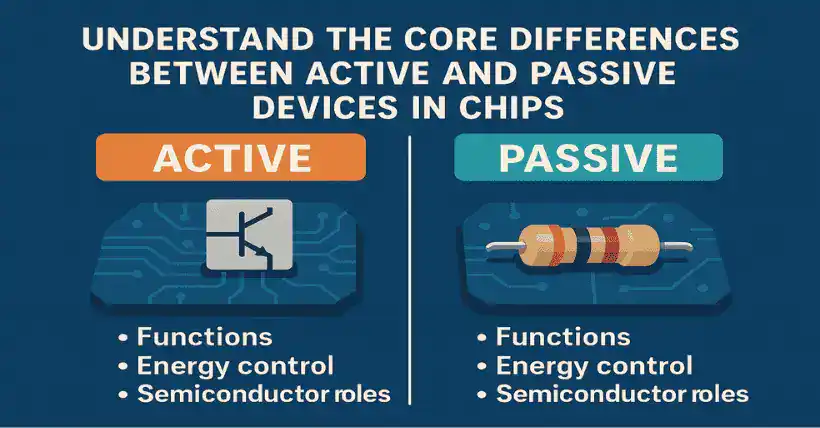In chips, active devices and passive devices are two core component categories, with significant differences in function, characteristics, and operating principles. The following is a detailed analysis:
| Active Devices | Passive Devices | |
|---|---|---|
| Definition | Devices that require external energy (such as a power supply) to operate. | Devices that operate without external energy and processes signals only by its own characteristics. |
Core Characteristics | Capable of signal amplification, energy conversion, or active control. | Only passive processing such as attenuation, filtering, and impedance matching can be performed on the signal |
01
Functional Differences Between Active and Passive Devices in Chips
- Active Devices: “Active Participants” in Signal Processing
Core Functions:
- Signal Amplification: Amplifiers (e.g., operational amplifiers, RF amplifiers) boost the amplitude of electrical signals and are key components in communication chips and processors.
- Energy Conversion: Oscillators convert DC power into high-frequency AC signals (e.g., clock signal generation), forming the basis for chip timing control.
- Logic Control: Transistors (MOSFETs, BJTs) form logic gates to perform binary operations (AND, OR, NOT), forming the core units of CPUs, FPGAs, and other digital chips.
Typical Applications:
- Digital Chips: Logic circuits in processors (CPU/GPU), read/write control in memory chips (DRAM/SRAM).
- Analog Chips: Power amplifiers (PAs) in RF chips, signal conditioning circuits in sensor interfaces.
- Passive Devices: “Passive Regulators” in Signal Transmission
Core Functions:
- Signal Filtering: RC/LC filters made of resistors, capacitors, and inductors are used to remove noise or select specific frequency signals (e.g., bandpass filters in RF chips).
- Impedance Matching: Resistor networks or inductor/capacitor combinations optimize signal reflection loss in transmission lines (e.g., termination resistors in high-speed interface chips).
- Energy Storage and Transfer: Capacitors store charge, inductors store magnetic energy, used in power filtering or signal coupling (e.g., decoupling capacitors within chips).
Typical Applications:
- Analog Chips: LC filter circuits in power management ICs (PMICs), anti-aliasing filters in ADCs/DACs.
- Digital Chips: LC resonant circuits in clock networks, parasitic resistance/capacitance modeling of on-chip interconnects.
02
Physical Structure and Manufacturing Process
- Active Devices: Rely on Semiconductor Technology
Structural Features:
- Based on semiconductor materials (e.g., silicon, germanium, gallium arsenide), forming PN junctions or metal-semiconductor junctions through doping processes (e.g., gate structure of MOSFETs).
- Manufactured through complex processes such as multilayer photolithography, ion implantation, and metal interconnects, with sizes down to the nanometer scale (e.g., 3nm transistors).
Representative Devices:
- Transistors (BJT, MOSFET, FinFET, GAAFET), diodes, thyristors, integrated circuits (ICs).
- Passive Devices: Simple Structures, Can Be Integrated or External
Structural Features:
- Generally simple physical structures, such as:
- Resistors: Made from doped polysilicon or metal films.
- Capacitors: Constructed using metal-insulator-metal (MIM) or metal-oxide-semiconductor (MOS) structures.
- Inductors: Formed with on-chip spiral metal wires or external magnetic core inductors (on-chip inductors are mostly used in high-frequency scenarios due to size constraints).
- Some passive devices (e.g., large inductors, capacitors) are external discrete components due to high integration costs.
Representative Devices:
- Resistors, capacitors, inductors, transformers, transmission lines, switches (pure physical switches without amplification).
03
Power Consumption and Performance Impact
- Active Devices: Primary Source of Power Consumption
- Require continuous energy from power supply during operation, being the main source of heat in chips (e.g., dynamic power consumption of CPUs from transistor switching).
- Performance limited by supply voltage and process nodes (e.g., reduced transistor drive capability at low voltage, requiring architectural optimization).
- Passive Devices: Low Power Consumption, Affect Signal Integrity
- Ideally consume no power (actual parasitic resistance causes minor energy loss).
- Performance bottlenecks come from parasitic parameters (e.g., parasitic capacitance/inductance of interconnects cause delay and crosstalk, limiting chip frequency increase).
04
Summary: Cooperative Function within Chips
Active devices are the “brain” and “power source” of chips, determining computing, control, and signal processing capabilities.
Passive devices are the “blood vessels” and “regulators” of chips, ensuring efficient and stable signal transmission.
Typical Example: In a 5G RF chip, the power amplifier (active device) amplifies signal power, while the LC matching network (passive device) optimizes the transmission efficiency of the signal from the amplifier to the antenna — both are indispensable.
Through well-designed cooperation between active and passive devices, chips can achieve diverse functions ranging from simple signal processing to complex system operations.

Disclaimer:
- This channel does not make any representations or warranties regarding the availability, accuracy, timeliness, effectiveness, or completeness of any information posted. It hereby disclaims any liability or consequences arising from the use of the information.
- This channel is non-commercial and non-profit. The re-posted content does not signify endorsement of its views or responsibility for its authenticity. It does not intend to constitute any other guidance. This channel is not liable for any inaccuracies or errors in the re-posted or published information, directly or indirectly.
- Some data, materials, text, images, etc., used in this channel are sourced from the internet, and all reposts are duly credited to their sources. If you discover any work that infringes on your intellectual property rights or personal legal interests, please contact us, and we will promptly modify or remove it.



